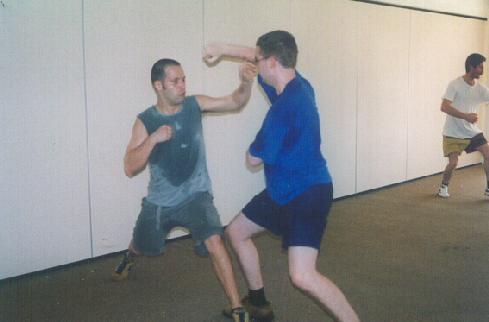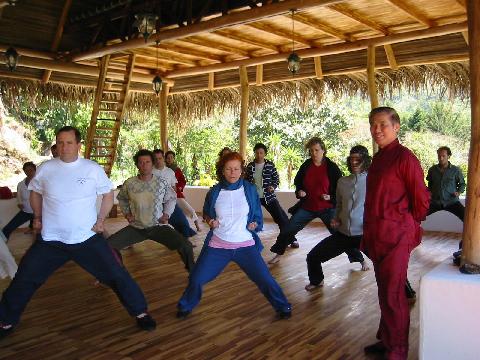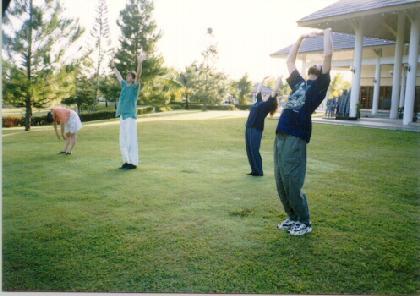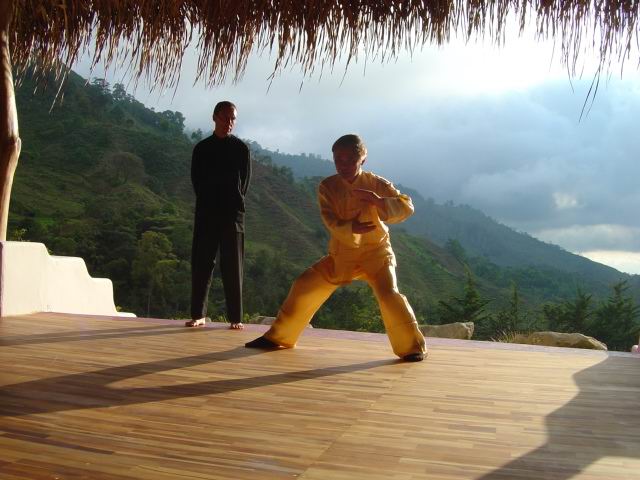August 2004 (Part 2)
SELECTION OF QUESTIONS AND ANSWERS

Roland and Don practiced sparring at the Intensive Shaolin Kungfu Course in Malaysia in March 2004
Question 1
I thought it would be time to write what I am doing. Since the Intensive Course a lot has happened and I traveled a lot. After the course we went to Kuala Lumpur (after Cameron Highlands) and to Borneo. It was amazing; we made a real jungle trip into Sungai Kinapatang and saw lots of animals — monkeys, scorpions, and elephants!
After that we went to Pulau Perhentian, a really nice island indeed! Then we went to Bangkok and the whole north of Thailand: it was just beautiful! We're still in Thailand, in Chiang Rai and we'll go to Laos soon.
I want to write some of my experiences down, which I've had since the Intensive Course. First I want to thank Sifu for all that you have shown me. Although I am a “little boy” in kungfu, I realize that the kungfu I practice is a real gift, a real superior art with a lot of secrets. I don't know why, but I really feel that what I am able to train now is what past masters did in the Shaolin Temple. I am so proud to be a part of that and I am even prouder to have such a real master. I want to say that I am really very proud to be your student!
— Roland, Switzerland
Answer
I am very proud of you too. Within a relatively short time, you have progressed tremendously. You have attained in 6 months in Shaolin Kungfu training what many people may not attain in three years, or even five years.
You exemplify the features of a good student, such as:
- You practice diligently not because you hope to become a master or want to save the world, but because you enjoy doing it.
- You spent time finding a good teacher then practice according to what he asks you to.
- You derive benefits from your practice according to what your art is purported to give.
- You have a sound philosophy of your practice.
- You are modest and treat your teacher respectfully (although you yourself is a trainer of world champions —- a fact that even many of our Shaolin Wahnam instructors may not know).
Question 2
I started my training as you had mentioned. So my main focus was again my stance training. As you had advised, I started to do all the stances without the hand forms. I started with 20 breaths for each stance. I must say that I really enjoy the stance training and I have felt after every session some power and joy and peace which I developed.
Answer
Your example should serve as a model and inspiration to others. Most people find stance training a torture, and many people suffer pain and develop physical tension as well as mental stress, yet have not developed any internal force even after training for many months. But you have developed power, joy and peace.
Why are your results different from those of most other people? The straightforward answer is that you practice correctly whereas the others do not. What makes your training correct whereas the others' wrong? The most important factor is that you make your stance training an exercise for relaxation (which is, of course, not easy) whereas the others make it a contest of endurance. Another important factor is that you persevere and progress gradually, whereas the others push themselves hard but give up easily.

Students practicing the Horse-Riding Stance at a Shaolin Kungfu class in Costa Rica
Question 3
I noticed very early that I got very long breaths (about 12-14 seconds per breath), so my stance training with the art of flexibility and the art of 100 kicks has taken me about one and a half hours! From time to time I could increase my counts of breaths. So one week ago I noticed that I had about 24 to 25 breaths for each stance.
The most incredible I noticed was when from time to time I just did the Golden Bridge stance to see how long I was able to stand. It was like a miracle to me. Before the course I could stand for about four and a half minutes! When I tested myself a week ago I could stay over seven and a half minutes! It was incredible for me to have such an improvement within this short time of training. I was very proud and happy.
Answer
Actually your progress is quite expected. If you follow my advice, which is actually the advice I reproduced from generations of past masters, you will surely attain what the training is purported to give.
Your approach is traditional, i.e. just practice stance training and the art of flexibility for a few months without doing other things else. This was the way of the masters in the past.
Nevertheless, as our modern situations are different, you may make some slight modification. Besides practicing the stances and the art of flexibility, which still constitute the main part of your training session, you can add some other aspects of training learnt from the Intensive Shaolin Kungfu Course.
Adding the art of 100 kicks is an excellent choice. Not only it will overcome your present weakness (which I mentioned to you during the course), it will also enhance the flexibility of your legs. In time you will turn your initial weakness into a strong point.
Other aspects you should add include One-Finger Shooting Zen, footwork training, kungfu sets, combat sequences and free sparring with an imaginary partner. You should choose only one or two aspects for each training session, which will take about 10-20% of your training time, leaving the remaining 80-90% to your core training, which constitutes stance training, the art of flexibility and the art of 100 kicks.
The main objective of the secondary training (about 10-20% of the training session) is to maintain the accuracy and efficiency of your performing these other aspects, so that later when the time is appropriate you can practice them correctly as core training. Hence, as you progress, you gradually reduce or remove some of the aspects in your present core training, and move up some of the other aspects from your present secondary training to become core training.
A useful way is to practice only Golden Bridge as core training, and the other stances once a while as secondary training. You can start with 25 or more breaths for Golden Bridge and gradually progress to 100 or more breaths. As you make appropriate shift of training aspects between core training and secondary training in your progress, by the time you can stand at Golden Bridge for 100 breaths, not only you will be very powerful and agile, you will also be fluid in your combat application.
If you find training for one and a half hours a bit too long, you can reduce it to just an hour. Remember that in our school, often “less is more”. But if you have enough time, enjoy your training, and are not over-training, you may continue with one and a half hours, or even gradually increase your training time. Generally, if you spent an hour training regularly using our Shaolin Wahnam methods, you can be quite proficient in a year. By then I hope you can qualify to be an instructor, helping Andrew to spread our Shaolin arts in your country.
Question 4
One or two days after testing my Horse Stance something happened suddenly. I felt really sick and had to go to a doctor. He found out that I got typical food poisoning. My girlfriend had the same disease. So I had to take antibiotics for one week. I was really sad, because since I began chi kung two and a half years ago, I've never had to take any medicine!
Did I train too much and did I improve too fast? Does my body want me to stop? I couldn't train stances for five days. The day before yesterday I restarted my training and found out that I was really tired. I know I am tired because of my antibiotics. Can you please give me some advice how to restart my training?
Answer
Don't worry about it. It happened to some dedicated students. It also happened to Jeffrey Segal a few years ago. I called it the “fast learners' syndrome”. There is quite a long explanation on this in my question-answer series. I can't remember which issue it was in.
You are right. Basically, you progress faster than what your physical body can normally take. Hence, Mother Nature asks you to take a rest. You can resume your training anytime. At first do not train for too long. Start with some “light” exercises, and focus more on chi flow.
It is natural that you may feel weak. It is not due to your loosing the energy that you have arduously trained. Rather, it is due to your having too much energy!
Most people would easily understand why one is tired when he does not have enough energy. But how can one be tired when he has too much energy?
The concept of yin-yang harmony will make this situation clearer. Here yin represents one's physical body and yang represents his energy level. If he has insufficient energy, he will not have yin-yang harmony, which means he will be sick, and this is due to insufficient yang. He will be tired because he does not have enough energy to work his body.
On the other hand, if he has too much energy, he will also be sick, and this yin-yang disharmony is due to excessive yang. He will also be tired because his body is too weak to sustain the working of his energy. This is your case.

Students practicing chi kung at an Intensive Chi Kung Course in Malaysia
Question 5
Why did I get sick? I thought I would have good health, so I wouldn't get sick due to some bacteria?
I know it is a matter of time until I am fit again. But training so hard and motivated and then loosing it very fast can be so disappointing. But I ask myself where all the energy I've build up has gone?
Answer
As you had been weakened, the bacteria made you sick. This is a paradox. If you had less energy, you might not be sick!
This situation may not be so surprising if we take an analogy of a car. Imagine a small car fixed with a big, powerful engine and forced to run fast. It would be damaged easily. If it has a small, less powerful engine, and runs less fast, it would last longer. Hence, masters have always warned against over-training, especially in internal force development.
Then, can one become very powerful, say, five times more powerful than when he first started his internal force training? Of course, he can, but he must take time so that his body, including all his cells, organs and systems, has sufficient time to adjust to his new energy level.
Let us look at the situation quantitatively. Suppose both your body and your energy are now at levels 50. Suppose, for some reasons, your energy level shoots up to 100, but your body level rises only to 60. You would then have a problem of yin-yang disharmony due to excessive yang.
At any one particular time, yin or yang may be slightly higher than the other. So long as the difference is slight and the period is short, there will not be a problem. For example, after a training session, your energy level may be at 60, while your body level at 50. After a rest, both your body and your energy may settle down at 55. Have you lost 5 units of energy? No. The 5 units of energy have been used to build your body.
Thus, over a reasonable period, during which time there will be mutual adjustment to attain equilibrium, both your body and your energy may reach levels 250. Your energy level is 5 times more powerful than before, but will your body be 5 times bigger? No, your body is 5 times stronger and more resilient, but not much bigger in size.
Understanding my explanation will make you realize that you need not be disappointed. In fact, you are going through a period of “fast learners' syndrome”. You have learnt an invaluable lesson first hand, a lesson that is particularly important when training to become a master. And your energy has not been lost. Yours is not a case of energy being drained away, but a case of your physical body being unable to sustain the rapid increase of energy.
Give yourself some rest and your physical body and energy level will adjust accordingly. Some gentle chi flow can speed up the adjustment.
Question 6
My wife is suffering from breast cancer. In August 2001, whe was diagnosed with cancer in her left breast. Soon after that she was operated, and subsequently given chemotherapy. Her doctor told us that the chance of a cure was 90%. However in Feb 2003 the breast cancer spread to her liver and right lung. She was treated with chemotherapy, and was in partial remission. The problem returned to haunt us in April this year.
We read in your book “The Art of Chi Kung” about the use of Chi Kung to cure cancer, and that you can transmit Chi to patients. I wonder whether you would be willing to help my wife.
— Michael, Australia
Answer
I am sorry to hear of your wife's cancer. Nevertheless, the good news is that cancer can be overcome, and many people have overcome cancer by practicing genuine chi kung.
From the Chinese medical perspective, cancer is due to some of the patient's bodily systems not working naturally (i.e. the ways nature has meant them to work). In Chinese medical jargon the disorder is referred to as yin-yang disharmony, and is due to disharmonious chi flow.
The resultant tumors are symptoms, not causes, of this disorder. An excellent way to overcome the disorder, i.e. to restore the natural working of the systems, is by practicing genuine chi kung. In Chinese medical jargon, this is ensuring harmonious chi flow to restore yin-yang harmony.
A basic principle in Chinese medical philosophy is to treat the disorder, not just the symptoms. When the symptoms are removed, the disorder may subside for some time, but new symptoms may appear elsewhere later on. This appears to be your wife's situation.
Nevertheless, as in the case of cancer, the symptoms may be life threatening, and thus removing them would be necessary. This would give the patient more time to work on the root cause.
I would recommend your wife to attend my Intensive Chi Kung Course. This is much better than merely transmitting chi to her. I cannot guarantee a cure, but I believe that if she continues to practice the chi kung exercises learnt in the course, she will have a good chance to recover.

Sifu Wong demonstrating a Taijiquan pattern at Costa Rica while Rama looked on
Question 7
I want to train Shaolin, Taichi Quan, Qi kong. But I don't know whish one should I train first. I have been smoking a lot for some months. Sometimes I have pain on my back. I am 27 years old.
— Hugo, Sweden
Answer
I would recommend that you start with qigong (chi kung). But I would strongly advise that you seek a genuine qigong teacher, otherwise you would be disappointed.
After practicing genuine qigong for about three months, your back pain should disappear. You can also throw away your cigararettes.
Then, if you like, you may choose either Shaolin Kungfu or Taijiquan. Again you must seek a genuine teacher. Naturally genuine qigong, Shaolin and Taijiquan teachers are hard to find. But in the long run, you will benefit much, much more to spend some time seeking a genuine teacher and paying higher fees than learning from books, videos or mediocre instructors who may teach you for free.
Question 8
I have practiced various forms of external martial arts in the past including Karate and Thai Boxing. I always have a fascination with both Aikido and Tai Chi. What advantages there are in Tai Chi over Aikido? My aim is to develop my spiritual side as well as my self defence skills. I appreciate this may be a difficult question but any insight you may have will be much appreciated.
— Craig, USA
Answer
This is not a difficult question. In fact the question is both important and interesting. The answer is also not difficult. For those who are informed or have direct experience of genuine Tai Chi Chuan and Aikido, the answer is obvious. It is only a difficult question for those who mistakenly think that Taijiquan is merely slow, graceful forms.
I would like to point out that my answer here is from the perspective of Tai Chi Chuan. You should also consult Aikido masters to have the other side of the picture.
I use the term “Tai Chi Chuan” instead of “Tai Chi”. In my webpages, Tai Chi Chuan refers to an internal martial art, whereas Tai Chi refers to a form of external dance-like exercise. Tai Chi Chuan is spelt as “Taijiquan” in Romanized Chinese, but in China today Taijiquan, which is one of the seven categories of wushu, is also practiced like an external dance, devoid of internal and martial dimensions.
To me, Tai Chi Chuan is superior to Aikido in all the four aspects of martial arts, namely form, force (or skill), application and philosophy.
The form of Tai Chi Chuan is often described as poetry in motion, whereas Aikido form, though beautiful by itself, lacks such depth of artistry. This, of course, is my personal opinion. Tai Chi Chuan form is systematic, designated into patterns, sequences and sets. Aikido does not have such facilities.
Each technique in Tai Chi Chuan is designated a name, which is both poetic and meaningful. Aikido does not have this advantage. If an Aikido master wishes to express a technique, he has to describe it in words, such as “Move in with your right leg, grip his arm or wrist, use your hip for leverage, and throw him backward onto the ground.”
To express the same technique, a Tai Chi Chuan master just has to say “Carry Tiger Back to Mountain”. His instruction is precise, and his students would know exactly what to do, whereas students of the Aikido master may not know the exact movements of the technique described in more words.
More significantly, because Tai Chi Chuan practitioners all over the world and throughout the centuries share the same vocabulary, it means that someone practicing Tai Chi Chuan today in the United States can benefit from the teaching of a master living in China two hundred years ago. Aikido students do not have this advantage.
The internal force of Tai Chi Chuan is fantastic. Without having to hit sandbags, carry weights or run a few miles a day, a Tai Chi Chuan practitioner, who may be an elegant woman of 60 years old, can spar for a few hours without feeling tired and comfortably handle able-bodied persons half her age and double her weight. A 60-year old woman practicing Aikido would not be able to do so.
The combat application of Taijiquan is complete; it can be used to handle any attacks. It may not be so in Aikido. Kicks, for example, are seldom or never used in Aikido to attack an opponent. The benefits of Taijiquan are directly applicable to non-combat purposes in daily life. The development of internal force and mind power in Taijiquan, for example, enables the practitioner to perform better whatever he does. Aikido is mainly concerned with advantageous use of momentum and leverage in physical movements, with little or no conscious training in energy and mind.
The great works and developments of Taijiquan by masters over many centuries have been richly recorded in classics, often in poetic forms. The resultant Taijiquan philosophy deals not only with combat but with holistic cultivation, leading to the highest spiritual attainment, called merging with Tao in Taijiquan, or returning to God in Western terms. Aikido, being a recent invention by just an indvidual, does not have such rich and deep philosophy.
LINKS
Selected Reading
- Why you can eat your cake and chocolate yet need not worry about cardiovascular diseases or diabetes
- Difference between Regional and Intensive Courses — Tobias Glosauer
- Sparring Methodology — Anthony Korahais
- Amazing Benefits from Intensive Taijiquan Course in Toronto — Brendan O'Toole
- Such Amazing Beauty and Magnificence — Jorge Leon García
